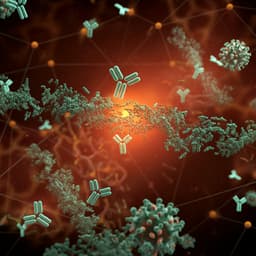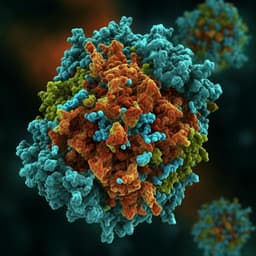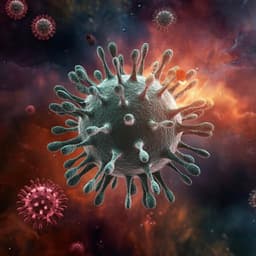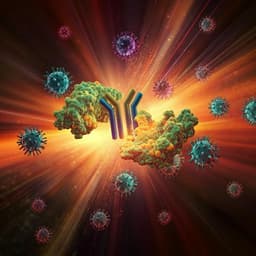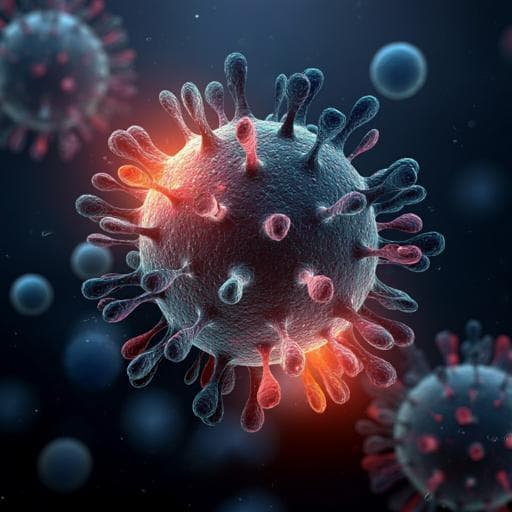
Medicine and Health
Potent SARS-CoV-2 neutralizing antibodies with protective efficacy against newly emerged mutational variants
T. Li, X. Han, et al.
Discover the groundbreaking research conducted by Tingting Li and colleagues as they reveal three powerful monoclonal antibodies that effectively neutralize SARS-CoV-2 and its variants. Their findings indicate not only significant protective effects in animal models but also highlight the potential for these antibodies in COVID-19 treatment.
~3 min • Beginner • English
Introduction
The persistence of COVID-19 in the global population can result in the accumulation of specific mutations of SARS-CoV-2 with increased infectivity and reduced susceptibility to neutralization. Highly transmissible variants such as B.1.351 (Beta) harbor multiple immune-escape mutations, raising concerns over the efficacy of existing interventions and the risk of reinfection. Neutralizing therapies have largely focused on antibodies targeting the receptor-binding domain (RBD) of Spike, the core region for ACE2 engagement. B.1.351 carries three RBD mutations (K417N, E484K, N501Y), with K417N and E484K implicated in escape from neutralizing antibodies and sera. While many RBD-directed antibodies lose potency against B.1.351, a subset retains in vitro activity, necessitating evaluation of their therapeutic efficacy against circulating strains. This study focuses on RBD-specific monoclonal antibodies from a curated reservoir to identify potent candidates that neutralize authentic SARS-CoV-2 and B.1.351 and to define their epitopes and mechanisms, aiming to inform antibody-based countermeasures for the ongoing pandemic.
Literature Review
Prior reports have shown that the D614G mutation increases infectivity and that variants such as B.1.351 and P.1 confer resistance to multiple monoclonal antibodies and to convalescent or vaccine-elicited sera. Structural studies have mapped common neutralizing epitopes on the RBD, including ACE2-binding surfaces, and have identified convergent antibody classes (e.g., IGHV1-58/IGKV3-20-derived antibodies). Despite widespread escape, some RBD-directed antibodies maintain potency against B.1.351, underscoring the need to assess their in vivo efficacy and structural determinants of breadth. The current work builds on these insights by selecting potent RBD mAbs, mapping their epitopes (including overlapping and independent sites), and determining structural mechanisms that underlie retained activity against E484K-containing variants.
Methodology
Human samples and antibody isolation: Blood samples were collected from 39 COVID-19 convalescent patients (average age ~65, predominantly mild disease) within two months post-discharge under institutional ethics approval and informed consent. Antigen-specific memory B cells were pooled (from 5–8 donors per pool) and sorted; paired IgG heavy and light chains were recovered by single-cell PCR, cloned into pVax1, and transiently expressed in Lenti-X293T cells for rapid screening of neutralization against SARS-CoV-2 pseudovirus.
Recombinant antibody production: Plasmids encoding heavy and light chains were co-transfected into Lenti-X293T cells; supernatants were harvested at 48 h and antibodies purified by Protein G Sepharose.
Neutralization assays with authentic virus: Neutralization of authentic SARS-CoV-2 was quantified by qRT-PCR after incubation of serially diluted mAbs with virus (10^5 TCID50) for 1 h at 37 °C, followed by infection of target cells for 6 h. Supernatants were collected for RNA extraction (Trizol) and qRT-PCR (LightCycler 480 II) using a standard cycling program. Neutralization of authentic SARS-CoV-2 (WN/004) and B.1.351 was also quantified by plaque-reduction neutralization testing (PRNT). Pseudovirus assays included B.1.1.7 and SARS-CoV-2 pseudoviruses.
Epitope mapping and competition: Competitive ELISAs grouped mAbs by competition with reference antibodies targeting distinct RBD epitopes (13G9-like, 81A11-like, CR3022-like, and others). Biotinylated mAbs were used in pairwise competition assays to define overlapping or independent epitopes. Additional peptide ELISAs used overlapping 20-mer peptides (RBD1–RBD15 covering S319–541) to identify linear binding regions; alanine scanning of a key peptide (RBD9-1, S444–481) mapped critical residues for binding.
Structural studies (cryo-EM): Fab fragments of 13G9 and 58G6 were complexed with a stabilized SARS-CoV-2 S trimer. Samples were vitrified and imaged on a Titan Krios with a K2 detector. Data were processed with MotionCor2 and CTFFIND4; particles were selected and 2D/3D classified and refined using RELION and cryoSPARC. Local refinements improved the RBD–Fab interface resolution (to ~3.5–3.8 Å). Model building used templates and de novo modeling in Phyre2 and Coot, with visualization in UCSF Chimera and PyMOL.
Surface plasmon resonance (SPR): Binding kinetics of mAbs to S1 (including B.1.351 S1) were measured on a Biacore X100 (CM5 chip), and competition assays assessed blocking of RBD–ACE2 interactions and mAb–mAb competition.
In vivo prophylaxis in hACE2 mice: Transgenic mice expressing hACE2 received a single intraperitoneal dose of mAb (10 mg/kg) or PBS 24 h prior to intranasal challenge with authentic SARS-CoV-2 (WIV04) or B.1.351. Body weight was monitored (up to day 3 in figure text; weight changes also reported up to day 6 in narrative). Lung viral loads were measured by PRNT at 3 days post-infection. All procedures were performed in ABSL-3 under approved animal protocols.
Key Findings
- Three RBD-specific mAbs (58G6, 510A5, 13G9) exhibited strong neutralization of authentic SARS-CoV-2, with IC50 values by qRT-PCR or PRNT in the low ng/mL range. Representative IC50s (from Fig. 1c):
• 58G6: ~9.978 ng/mL (authentic, qRT-PCR); 6.025 ng/mL (pseudovirus PRNT)
• 510A5: ~11.130 ng/mL (authentic, qRT-PCR); 1.265 ng/mL (pseudovirus PRNT)
• 13G9: ~6.958 ng/mL (authentic, qRT-PCR); 9.174 ng/mL (pseudovirus PRNT)
Other tested mAbs were less potent (e.g., 510D7 and 511E10 >5000 ng/mL in PRNT).
- Potency against variants: Despite immune-escape mutations in B.1.351, 58G6 and 510A5 maintained strong neutralization of authentic B.1.351, with IC50s reported as low as approximately 2 ng/mL in some assays. Neutralizing potency against B.1.1.7 pseudovirus was similar to that against SARS-CoV-2 pseudovirus.
- Binding and epitope mapping:
• 58G6 binds a linear region within denatured RBD centered on S450–457 and also engages S450–458 in native RBD; the broader S445–463 region contributes to ACE2 interaction and is competitively blocked by 58G6.
• 13G9 did not bind denatured RBD peptides but competes at an overlapping epitope class with many potent neutralizers.
• Cryo-EM showed both 13G9 and 58G6 recognize a steric epitope spanning RBD residues 470–495 that overlaps the ACE2-binding site, explaining direct ACE2 blocking.
• Structural analyses revealed hydrogen bonds within the 470–495 region, including interactions near residue 484; 58G6 engages backbone atoms at S/E484, consistent with retained affinity to E484K variants, whereas 13G9 may be more sensitive to E484K due to potential electrostatic effects.
• Both Fabs bound RBDs in the S trimer with all three RBDs in the up conformation (3 Fabs per trimer in dominant classes), potentially occluding ACE2 access.
- In vivo efficacy: Prophylactic administration of 58G6 or 510A5 (10 mg/kg i.p., 24 h pre-challenge) protected hACE2 transgenic mice from weight loss after challenge with authentic SARS-CoV-2 (WIV04) or B.1.351, and significantly reduced lung viral loads at 3 dpi compared to PBS controls.
- Antibody gene usage: 13G9 and 58G6 were both derived from IGHV1-58 and IGKV3-20, consistent with a convergent class of potent RBD-directed neutralizing antibodies.
Discussion
This study addresses the challenge posed by emerging SARS-CoV-2 variants, particularly B.1.351, which exhibits resistance to many neutralizing antibodies. By selecting RBD-specific mAbs from convalescent donors, the authors identified 58G6 and 510A5 as potent neutralizers of authentic SARS-CoV-2 and B.1.351. Structural and epitope analyses explain their breadth: both target a vulnerable, ACE2-overlapping epitope (RBD 470–495), and 58G6 additionally recognizes a linear segment (450–458/450–457) that is critical for ACE2 engagement. The interaction of 58G6 with backbone atoms near residue 484 likely underlies its tolerance to the E484K mutation, preserving affinity and neutralization of B.1.351 and potentially P.1. In vivo, a single prophylactic dose protected hACE2 mice from disease signs and reduced viral burden for both ancestral and B.1.351 strains, supporting translational potential. The observation that both 13G9 and 58G6 are IGHV1-58/IGKV3-20 antibodies aligns with known convergent, potent RBD-directed antibody classes and may guide vaccine or therapeutic design toward these epitopes. Although full mechanistic implications of the all-RBD-up binding mode remain to be established, complete occupancy likely contributes to ACE2 blockade and neutralization.
Conclusion
The authors identify and characterize two potent, broadly effective RBD-targeting monoclonal antibodies, 58G6 and 510A5, that neutralize authentic SARS-CoV-2 and the immune-escape variant B.1.351 with low-ng/mL potency. Structural analyses reveal that both antibodies target an ACE2-overlapping epitope (470–495), with 58G6 additionally engaging a linear RBD segment (450–458) critical for ACE2 binding, explaining resilience to E484K. Prophylactic administration protects hACE2 mice from weight loss and reduces lung viral loads for both strains, highlighting their therapeutic promise against ongoing and future SARS-CoV-2 variants. Future work should evaluate therapeutic (post-exposure) efficacy, breadth against additional and newer variants, resistance pathways under antibody pressure, and structural/functional consequences of the observed all-RBD-up binding mode, as well as optimization of antibody combinations to prevent escape.
Limitations
- Donor linkage: Due to the antibody isolation approach (pooled memory B cells), specific mAbs could not be definitively linked to individual donor samples.
- Structural interpretation: While cryo-EM shows full Fab occupancy with RBDs in the up state, the functional significance and prevalence of this conformation across particles remain to be fully established.
- In vivo scope: Mouse experiments assessed prophylactic protection with a single dose and early time points; therapeutic efficacy, dose–response, and longer-term outcomes were not reported.
- Variant coverage: Detailed quantitative neutralization data against a broad panel of variants beyond B.1.351 and B.1.1.7 were not fully presented in the provided text.
- Some antibodies (e.g., 13G9) may be partially affected by E484K; comprehensive mapping of escape mutations for each mAb would strengthen conclusions.
Related Publications
Explore these studies to deepen your understanding of the subject.



